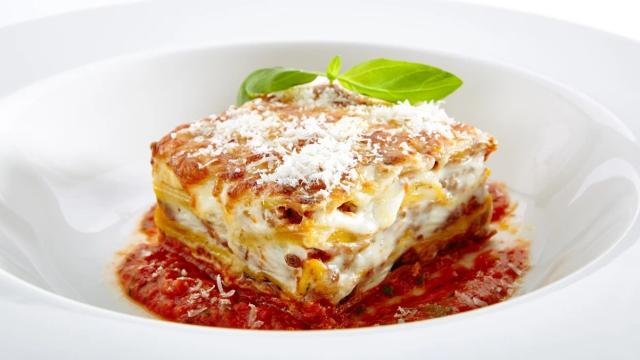Growing up, homemade lasagna was one of a variety of massive meals my mom would assemble to feed the three bottomless pits that were her children. But when I finally tried lasagna at a restaurant, I noticed some distinct differences—it was taller than my mom’s, for one thing, made up of discernible layers that didn’t slide apart—and there wasn’t any water pooling around it on my plate.
No shade on my mom or anyone else who likes their lasagna to be kind of like a pudding, but if you want to make a more restaurant-style lasagna at home, here are some tips to get you there.
Use a loaf pan for some height

Credit: Allie Chanthorn Reinmann
Restaurants serve stately slices of lasagna, and part of achieving that look is height. Unless you need a large casserole dish to make 12 to 16 servings of lasagna, try building it in a loaf pan. These are typically three quarters to a full inch taller than many casserole dishes. Using a loaf pan also eliminates the “middle piece,” that slice with no crispy edges. That slice is almost always the swampiest and the saddest, because there are no crunchy bits.
That’s because the loaf pan is easier to fill because its width is almost exactly two lasagna strips wide, which means some slight overlapping, but a lot less puzzling parts together. I find this improves the structure overall. If you’re worried about slicing and scooping out of a loaf pan, line the inside snuggly with buttered foil before assembly. Allow the foil to come up over the top as a handle for later. When the lasagna is finished and cooled, you can lift the whole thing out for slicing.
Go easy on the sauce

Credit: Allie Chanthorn Reinmann
For cleanly stacking layers and easy cutting, don’t flood the dish with watery sauce. This is what leads to layers sliding apart—the pasta noodles are hydroplaning every time you go to cut a bite. Instead, make a “dry” sauce for layering. If you’re using meat, break it apart into fine chunks, brown it, and season it. Then only add enough tomato sauce to coat the meat completely, but not to make a soup. (Lasagna soup is for another time.) Layer the sauce in a thin but complete layer before adding the next set of noodles. Not only will the structure be more stable, but the sauce will be way more meaty. If you love tomato gravy and you’re wondering where the rest of it will go, there’s a trick for that too.
A clever technique in restaurant plating is to apply the sauce underneath. Warm up the loose tomato sauce (no need to make it “dry” anymore) in a small pot. When you’re ready to serve the lasagna, spoon some sauce onto a plate. Place the tall, stable slice of lasagna right on top.
Reduce the moisture
Related to the sauce tip, try to reduce moisture in general. Under high heat and long bake times fresh cheeses and vegetables will release water. This water is free-roaming, it’s not emulsified or captured in any other component, so when you serve it the water pools up on your plate or in your casserole dish.
Instead of using fresh mozzarella, try using the low-moisture variety. Skip the ricotta cheese. If you think you’ll miss the creaminess, try layering in a béchamel sauce. Or if you can’t live without it, press the ricotta with paper towels beforehand to remove the excess water. Any vegetables you want to mix in should have a quick sautée on the stove to cook them and that will take out quite a bit of extra water. It’s also a valuable opportunity for seasoning the vegetables, which should never be underestimated.
Cool it before slicing
Not only is this step crucial for clean slices, but a bite of piping hot lasagna is always followed by three or four days of deep regret. Allowing the lasagna to cool down to around room temperature will allow the fats in the cheese and meat to firm up again. This is especially helpful if you’re lifting the whole loaf of lasagna out of the pan with the foil liner. When you slice it to serve there will be much less squishing, yielding cleaner slices with sharp edges. (While it isn’t necessary to delay your lasagna to the next day, fridge-cold leftovers will be even easier to cut through, and you can reheat it in the microwave after it’s sliced.)
After slicing, if you want the tops of your lasagna servings to be melty, you can line up the slices on a parchment-lined baking sheet and give them a quick broil. Just a minute or two to reheat the tops before plating. The cheese will be toasty and the rest of the lasagna will remain pleasantly warm. The roof of your mouth will thank you.

Leave a Reply
You must be logged in to post a comment.